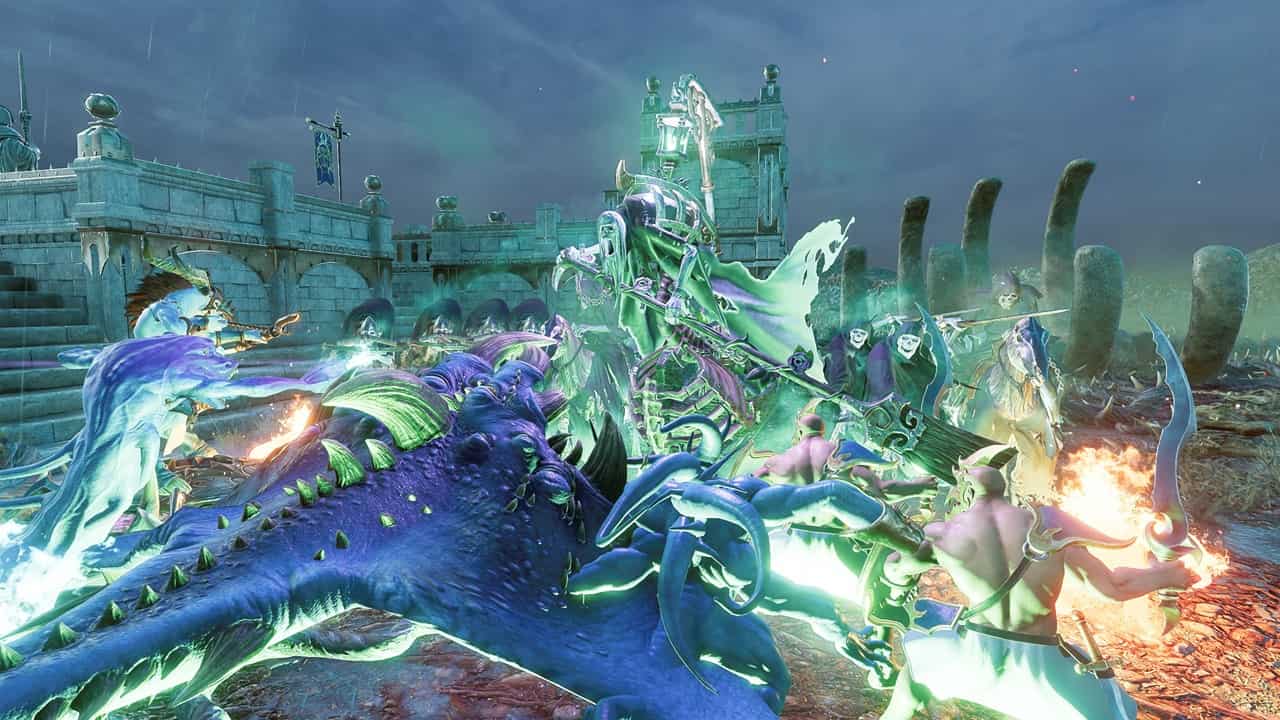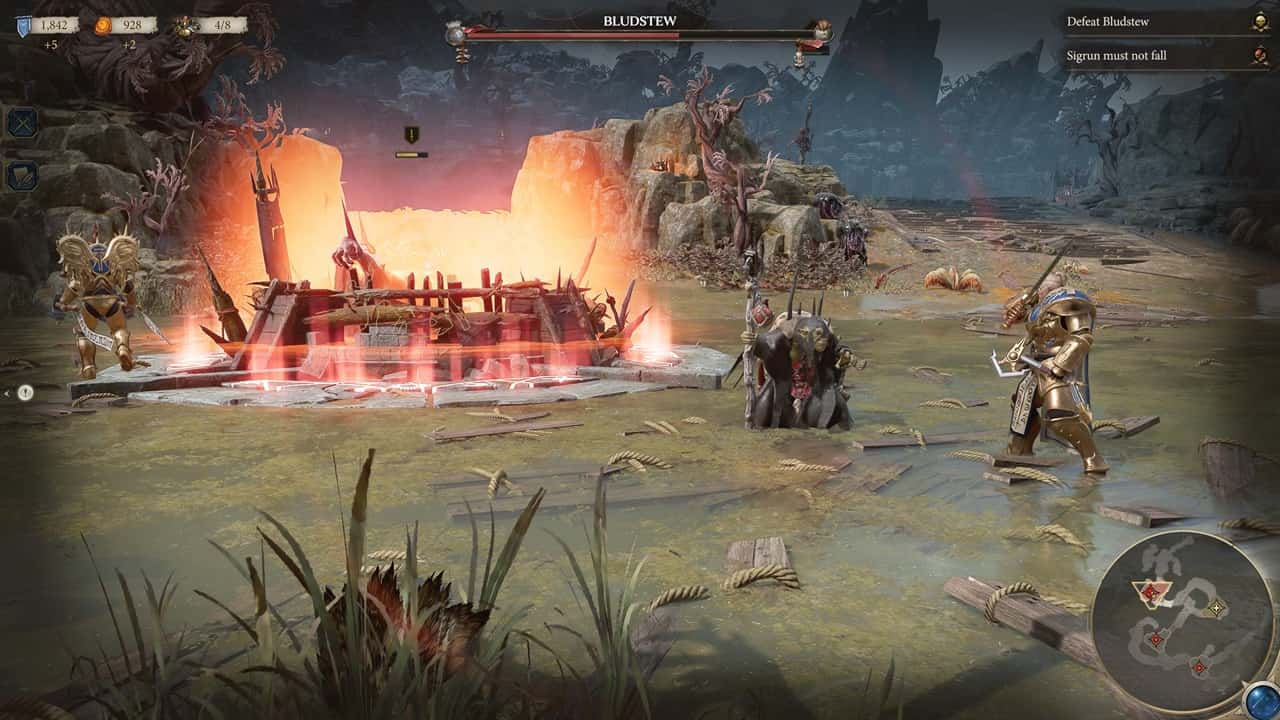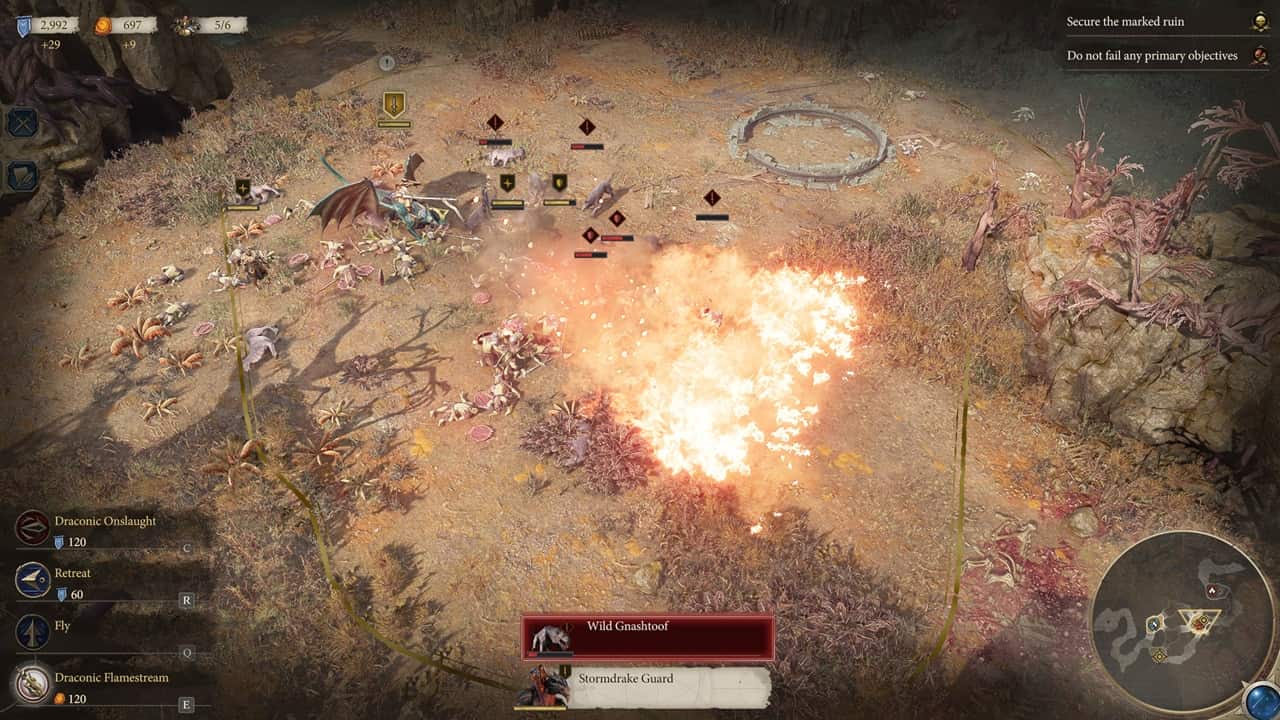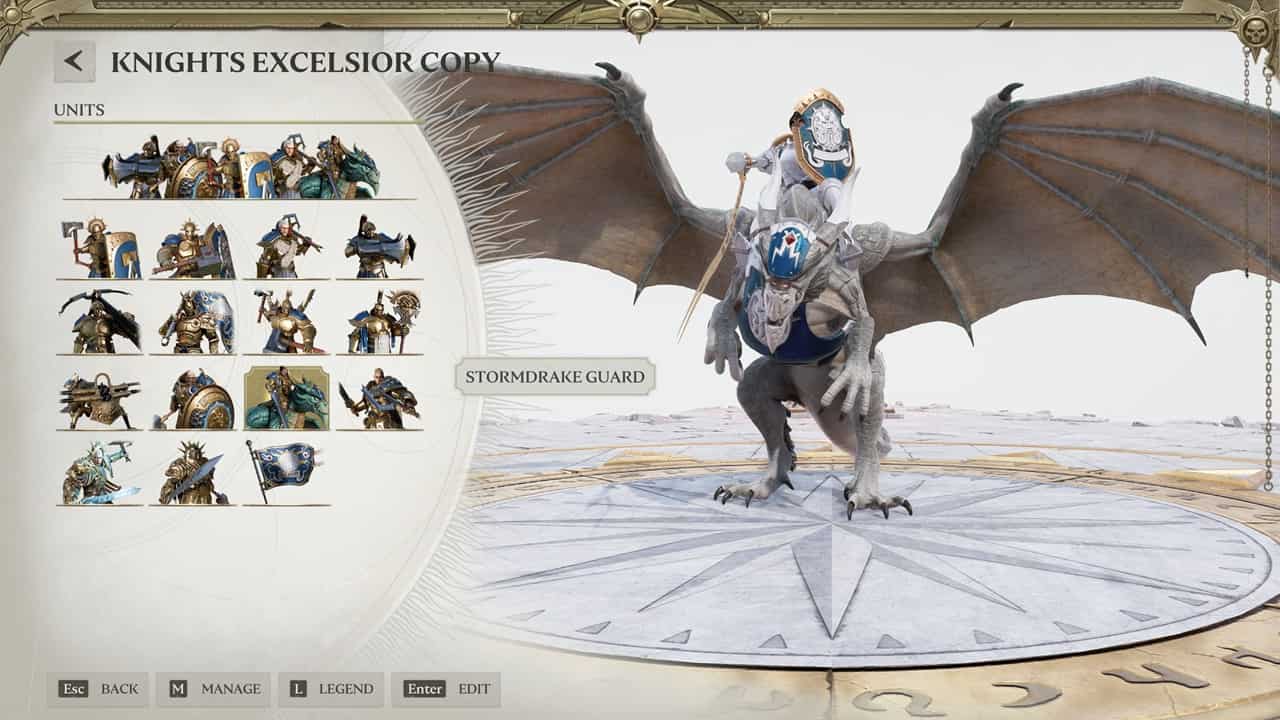Video Gamer is reader-supported. When you buy through links on our site, we may earn an affiliate commission. Prices subject to change. Learn more
For a real-time strategy title with accessibility as a core pillar, Warhammer Age Of Sigmar: Realms Of Ruin’s worship of rapid micromanagement comes as a surprise. If that’s your idea of a good time, Frontier Developments gets the basics right. From positioning to attack and ability commands, every sliver of your attention is contested across its fantasy maps. With asymmetric factions and rock-paper-scissors counters for its squads, Realms of Ruin harnesses the lost glory of games like Dawn of War and older Warhammer RTS titles.
A distilled RTS experience with less busywork paired with splendid visuals and tabletop figurine-grade customization options isn’t easy to pull off. The battlegrounds of the realm of Ghur are stunning, from smears of marshland to forsaken lands and besieged cities. The Stormcast Eternals, Orruk Kruleboyz, Nighthaunt, and the Disciples Of Tzeentch factions received a great deal of attention, particularly in the balance and visual departments. The only exception I can think of in terms of balance is the squad-wiping Flamers of Tzeentch.
In terms of design, moving as a fog of clothes, armor, and death as the Nighthaunt feels incredible. But Realms of Ruin’s campaign seldom reaches the narrative peaks of the ol’ RTS flagbearers. Despite that, both RTS fans and beginners will find a lot to sink their glowing blades into.

Among the four factions, you start as the lightning-wielding marines in gold. The Stormcast Eternals and their heroes walk their tropes well, with pompous dialogue and bland platitudes for banter. All that talk about artefacts and prophecy makes the stereotypical Orruk Kruleboyz better company with their guttural slang and one-note motives. While I was drawn to the Lord of the Rings Nazgul-like Nighthaunt and power-hungry Disciples Of Tzeentch, they don’t get as much of a spotlight across the campaign’s 18 chapters.
These chapters feature unique objectives and map designs that don’t reduce them to traditional multiplayer rounds. From holding victory points against hordes of foes to sneaking about as a lone hero behind enemy lines, some of them reminded me of StarCraft 2 and Warcraft 3’s best moments. Stopping an undead procession with Arcane Conduits (the game’s build points) felt great. And while Realms of Ruin does sprinkle some surprises across its overarching storyline, they don’t stun you like its spiritual predecessors. In short, its rebooted Mortal Realms setting pales in comparison to the gritty fantasy angle I adore from the Total War titles.

Base-building is thankfully simple, perhaps too simple. Command and Realmstone are two resources generated by capturing Arcane Conduits across the map. Build a particular structure on these conduits to generate a resource, deal damage to nearby enemies, or heal allied units and raise your population cap. Troops themselves can only be summoned from a Muster Point, a main base that houses unit-specific upgrades and access to elite units. Refilling your squad members at your base or appropriately upgraded Arcane Conduits can take a while. But it’s cheaper than recruiting fresh squads. Watching them crawl to the frontlines can feel agonizing, especially when your conduits and victory points are contested.
Combat is dictated by the counter triangle common in RTS titles. Melee beats armor, armor beats ranged, and ranged beats melee. Hero units exist outside this counter system but they aren’t invincible. Unlike other hero-focused RTS games, leave these heroes unattended and their health bars will wither away like autumn trees. Nearly every unit has unique abilities that range from defense boosts and attacks to situational bonuses.
Once your squad locks swords with an enemy, they can’t be pulled back unless you hit the panic button. Canceling a command at the last moment is nigh impossible. A retreat command sends a squad rushing to your base with bonus movement if things go sideways. Send enough units to your base and the match can turn into a drawn-out defeat. Every second of your time demands decision-making in Realms of Ruin.

The game’s AI combatants are a mixed bag. As I stumbled to prop up an attack force or defend a build point, I saw my troops idly watch enemy archers as they rained bolts on them. Unit pathing can get weird sometimes, with units dancing around foes instead of sinking an axe into them. As for the enemies themselves, they were more than competent at harassing undefended build points and isolated squads.
Since each side has access to a limited number of squads, things don’t always go by the numbers if you account for the combat triangle in your unit composition. Even with powerful endgame units like the flying Stormdrake Guard, you’ll need to obey the combat triangle to survive. You can’t swarm an enemy choke point without leaving yourself vulnerable elsewhere. But if you’ve got the resources, replacing entire squads wholesale is quicker than healing them.
While the game’s pacing felt slow in earlier footage, I’m happy to report that the developers quickly acted on this feedback to speed up squad animations. While it doesn’t have the fleet foot pacing of Command and Conquer, Realms of Ruin’s units have a sense of weight to them. This makes timing an important factor as you tussle against AI and human opponents. By shedding the elaborate base building and economy management of its peers, this RTS focuses on tactics over all else. The game wisely refrains from assaulting you with information, with health, attacks, and shield values nowhere to be seen. Fights are less about the fastest clicks and more about how efficient your upgrade path is and how you balance your army composition. A hasty misclick can cost you a skirmish if not the entire round.

Step back from its combat and Realms of Ruin hooks figurine collectors with an elaborate livery editor that lets you tinker with every single unit in the game. While a dedicated map editor lets you create battlefields, I enjoyed creating setpieces here instead with the scene editor. That’s where the first image in this review comes from. Livery presets include legions noteworthy in Warhammer lore. I wish I could dent shields and weather their armor instead of just dictating color schemes.
Once you’ve kitted out your units with a fresh coat of paint, take them along for Conquest and multiplayer matches with crossplay support. Even with a refined control scheme, players using a controller will only be able to make fewer decisions than their keyboard-and-mouse counterparts. While the procedural Conquest mode tries to entice solo players with unique modifiers across its duels, it’s no match for StarCraft 2’s stellar co-op missions. But since the latter had over a decade to polish and iron out quirks, it isn’t a fair comparison.
As the game leans toward oversimplification rather than streamlining, it may discourage RTS veterans. While this decision should be backed up by Realms of Ruin’s reliance on fervent clicks and squad-based tactics, its iffy pathing works against your clever tricks instead of enabling them. While Realms of Ruin looks great and plays it safe, zoom out from its Warhammer character models and fundamentals to spot unreliable troop controls that turn traps into tombs. Despite that, it has the potential to turn a newcomer into a Warhammer universe devotee.
Reviewed on PC. Game provided by publisher.

